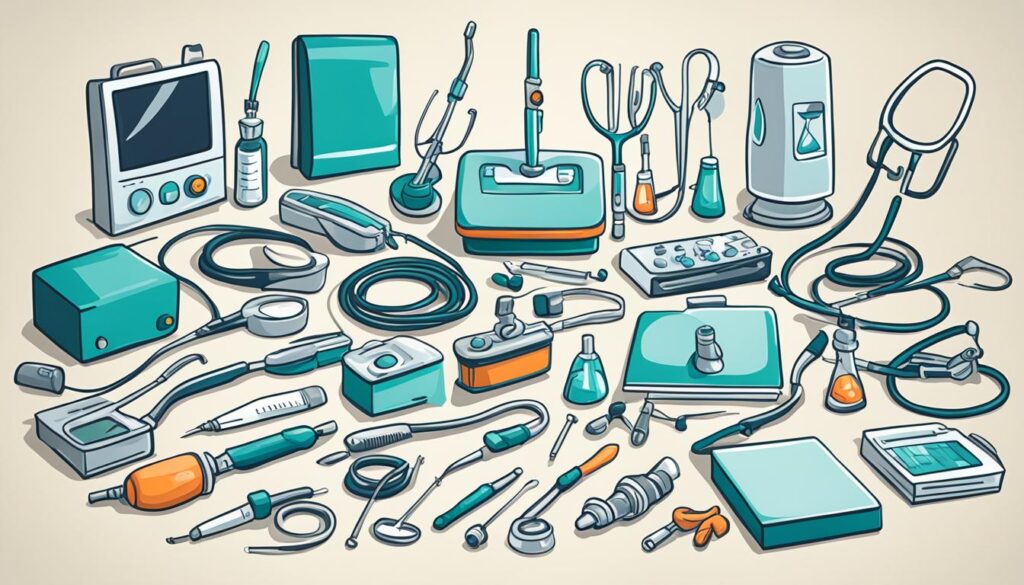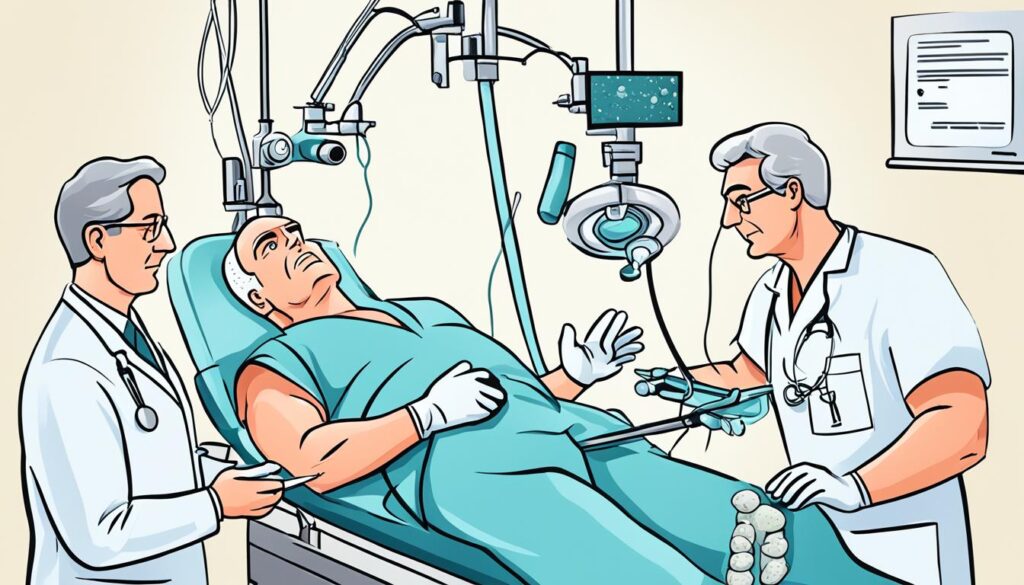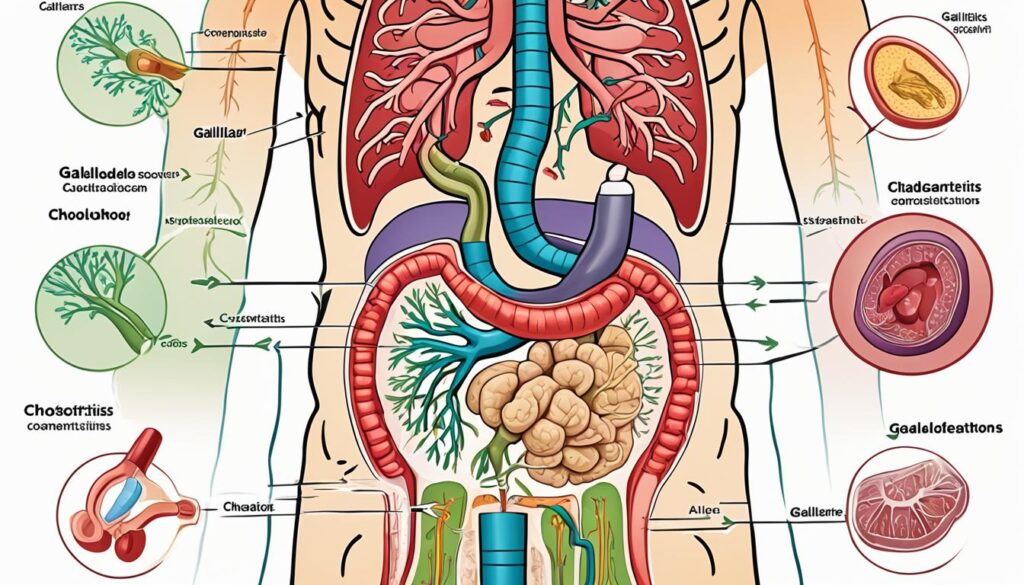Gallstones are hard deposits in the gallbladder that can lead to stomach pain and nausea. Treating them may involve medicine, small surgeries, or taking out the gallbladder. This article looks at different ways to treat gallstones, from waiting and watching to removing the gallbladder.
Table of Contents
ToggleBy knowing your choices, you and your doctor can make a plan that fits you best. This plan can help deal with your symptoms and get you feeling better.
Understanding Gallstones
What are Gallstones?
Gallstones are hard pieces of digestive fluid in the gallbladder. They range from tiny grains to big golf balls. Mostly made of cholesterol and bile, they form when red blood cell waste interacts with the digestive system.
Causes and Risk Factors
Being female, overweight, or obese raises your gallstone risk. So does losing weight rapidly, being pregnant, and having certain health issues like diabetes and high triglyceride levels.
Symptoms of Gallstones
Severe pain in the middle or upper right part of the belly is a big symptom. You might also feel sick, throw up, and see your skin and eyes turn yellow. This pain can come quickly, feeling sharp, making you sweat, and causing your heart to beat faster.
Diagnosis of Gallstones
Doctors use different tests to find gallstones. These include an abdominal ultrasound, an endoscopic ultrasound (EUS), and blood tests. The most common test is the abdominal ultrasound. It can see if you have gallstones and check your gallbladder.
Abdominal Ultrasound
An abdominal ultrasound is the main way to diagnose gallstones. It’s a painless test that uses sound waves. It lets the doctors see inside your body and find any gallstones.
Endoscopic Ultrasound (EUS)
A more detailed test called endoscopic ultrasound (EUS) can find even small gallstones. It uses a small tube with a camera and ultrasound. This tube goes into your stomach and duodenum to get a closer look at your bile ducts and gallbladder.
Other Imaging Tests
Besides ultrasounds, doctors may use different imaging scans to see gallstones. Tests like oral cholecystography, HIDA scans, CT scans, and MRCP give detailed pictures. They can show more about where the stones are and what they look like.
Blood Tests
Blood tests are also helpful. They look for signs of infection, jaundice, or pancreatitis. These signs might mean you have gallstones or problems from them.
Endoscopic Retrograde Cholangiopancreatography (ERCP)
Endoscopic retrograde cholangiopancreatography (ERCP) uses a special dye and X-rays to see the bile ducts and pancreatic duct. A doctor puts a thin tube with a camera down your throat. This tube lets them see inside your body. They then add dye through a small tube. The dye helps find and maybe take out any gallstones.
| ERCP for Gallstones: Key Facts |
|---|
| Complications may occur in about 5% to 10% of ERCP procedures, including pancreatitis, bile duct or gallbladder infections, excessive bleeding, perforations, and abnormal reactions to sedatives. |
| Immediate medical care may be required after an ERCP if experiencing symptoms like bloody or black stool, fever, severe chest or abdominal pain, breathing difficulties, swallowing problems, or worsening throat pain. |
| Patients typically remain at the hospital or outpatient center for 2 to 6 hours after an ERCP for the sedative or anesthesia effects to diminish, with some individuals needing an overnight stay. |
| Instructions may include following a clear-liquid diet for 4 to 6 hours post-procedure, with some individuals delaying solid food intake up to 24 hours. |
| Immediate test results from ERCP might be shared after sedatives wear off, while biopsy results could take several days or longer to return. |
| Specific medication adjustments or cessation may be needed before the procedure, and patients must inform their doctor if pregnant to safeguard the fetus during the ERCP. |
ERCP may lead to issues like pancreatitis, needing hospital treatment. Still, it’s good for finding problems with the bile and pancreatic ducts. Doctors can also use MRI or ultrasounds without risk to help diagnose issues.
Doctors use ERCP to handle issues like gallstones or infections. It’s a mix of looking inside with a tube and seeing with X-rays. They can then fix these problems using special tools.
Treatment Options for Gallstones
The treatment you get for gallstones depends on how they affect you and what type they are. If someone has gallstones but no symptoms, a doctor might suggest keeping an eye on them. This means checking if they cause any problems over time. But, if the gallstones make you feel bad or cause issues, taking out the gallbladder through surgery is usually the best choice.
Watchful Waiting
For people with silent gallstones, these might not need immediate action. Watching and waiting to see if they become troublesome is one option. It’s for those who feel fine and don’t have any issues from their gallstones yet.
Surgery: Cholecystectomy
Getting the gallbladder removed is very common in the United States. This surgery, known as cholecystectomy, is often done with a small cut. It’s called laparoscopic surgery. It has benefits like less pain, a shorter time in the hospital, and coming back to your regular life faster. Sometimes, though, the operation might need a larger cut if the doctor finds certain problems.
Medications to Dissolve Gallstones
Some medicines can help dissolve small cholesterol gallstones. They are made from bile acids, like ursodiol and chenodiol. But, this way isn’t used a lot because it takes a long time to work. Also, the gallstones might come back within five years after using these medicines. That’s why doctors usually prefer surgery over medication.

Surgical Treatment: Cholecystectomy
Cholecystectomy removes the gallbladder. It’s a frequent surgery for adults in the U.S. It is the top choice for those with gallstone issues or complications.
Laparoscopic Cholecystectomy
Laparoscopic surgery is common for this. It’s a small incision surgery. A camera and special tools remove the gallbladder. This way is less painful with a shorter hospital stay.
Open Cholecystectomy
Sometimes, surgery changes to open. This could be because of scarring or infection. The surgeon makes a bigger cut to remove the gallbladder directly. While not used as much, it helps in some complex cases.
Nonsurgical Treatments
Surgery, like gallbladder removal, is the usual way to treat gallstones. Yet, some people might not be able to have surgery. This could be because of other health issues. Or they might prefer a different option.
Endoscopic Retrograde Cholangiopancreatography (ERCP)
ERCP helps remove gallstones stuck in the bile duct. A camera-tube goes down your throat into the intestine. Then, a small tube gets used to add dye.
This dye lets doctors see and take out the gallstones.
Oral Dissolution Therapy
Medicines like ursodiol and chenodiol can dissolve little, cholesterol gallstones. But, this way takes a long time to work. And the stones might come back.
It’s good for those who can’t have surgery or other big treatments.
Shock Wave Lithotripsy
Shock wave lithotripsy breaks gallstones with sound waves. Then, your body can pass out the smaller pieces. This method might be used with a medicine that helps break down the remaining pieces.
But, not many people can get this treatment. Only around 15% qualify for it.

gallstones medical treatment
For gallstones, doctors have different ways to help. They might use medicines or do surgeries or other small procedures. Some drugs can help dissolve certain types of stones, but it might take a long time.
Medication
Some gallstones can be treated with medicines like bile acids. This might mean taking these medicines for a long time. If you stop taking the medicine, the stones could come back.
Surgery
When gallstones cause problems, surgery might be needed. Doctors could take out the gallbladder using small cuts. This surgery is usually done with special tools and a camera.
Extracorporeal Shock Wave Lithotripsy
If surgery isn’t an option, a procedure called ESWL can help. It uses sound waves to break the stones into small pieces. Then, the body can get rid of them easier.
Percutaneous Therapy
Percutaneous therapy means removing stones through a small cut in the belly. It’s a less invasive choice for some patients. This is good for stones that are hard to treat surgically.
Endoscopic Gallbladder Stenting
For some people, putting a stent in might be the best choice. This is for those who can’t have surgery. A stent can help keep bile moving, reducing problems from the stones.
Treating Complications of Gallstones
Gallstones can cause problems needing more than basic care. These issues must be understood to help those with gallstone-related health troubles fully.
Acute Cholecystitis
When a gallstone blocks the cystic duct, it can cause acute cholecystitis. This leads to gallbladder inflammation. Usually, removing the gallbladder with surgery is the best treatment. But patients might need antibiotics first to prepare for the operation.
Choledocholithiasis
If gallstones block the common bile duct, choledocholithiasis can happen. This is very dangerous and can cause infections or worse. To treat this, doctors use a procedure called ERCP to find and remove the stones.
Other Complications
There are rarer complications, like cholecystoenteric fistulas or Mirizzi’s syndrome. They might need both surgery and procedures like ERCP for diagnosis and treatment. The right approach depends on the case.

Prevention of Gallstones
Some risk factors, like genetics, can’t be changed. But you can still do a lot to avoid gallstones. Keep a healthy weight by eating lots of fiber and right fats. Cut back on refined carbs and sugar. And move your body often.
Here’s how you can prevent gallstones:
- Eat plenty of fiber from fruits, veggies, and whole grains. This helps with bile and lowers your gallstone risk.
- Use healthy fats like those in olive oil, avocados, and nuts. They help with cholesterol and keep your gallbladder healthy.
- Avoid too many refined carbs and sugary treats. They make you gain weight and up your gallstone danger.
- Stay active with things like walking, swimming, or biking to keep your weight in check and help your gallbladder.
- If you’re too heavy, your doctor can help you lose weight safely. Quick weight loss can cause gallstones.
By changing your lifestyle like this, you cut down on gallstone risks. It might save you from needing tough medical steps.
Conclusion
Gallstones can cause a lot of pain and may be serious, but there’s hope. Many treatments work well.
Your doctor can help choose what’s best for you. From watchful waiting to taking out the gallbladder, you have options.
Knowing your choices and what might go wrong can make you healthier. Lots of people face gallstones, about 20% of Europeans. So, others are on this path, too.
If you’re in pain from gallstones or just worried, learning and communication are key. Working with your medical team ensures good care. Then, you can manage your health and enjoy life more.
FAQ
What are gallstones?
What causes gallstones?
What are the symptoms of gallstones?
How are gallstones diagnosed?
What is endoscopic retrograde cholangiopancreatography (ERCP)?
What are the treatment options for gallstones?
What is cholecystectomy?
What are the nonsurgical treatment options for gallstones?
What are the potential complications of gallstones?
How can I prevent gallstones?
Source Links
- https://www.mayoclinic.org/diseases-conditions/gallstones/diagnosis-treatment/drc-20354220
- https://www.niddk.nih.gov/health-information/digestive-diseases/gallstones/treatment
- https://www.hopkinsmedicine.org/health/conditions-and-diseases/gallstone-disease-treatment
- https://my.clevelandclinic.org/health/diseases/7313-gallstones
- https://www.niddk.nih.gov/health-information/diagnostic-tests/endoscopic-retrograde-cholangiopancreatography
- https://www.bangkokhospital.com/en/content/ercp-and-laparoscopic-cholecystectomy
- https://www.mayoclinic.org/tests-procedures/cholecystectomy/about/pac-20384818
- https://www.everydayhealth.com/gallbladder/non-surgical-treatments-for-gallstones.aspx
- https://www.ncbi.nlm.nih.gov/pmc/articles/PMC7132079/


